spark plug Lancia Thesis 2007 Owner handbook (in English)
[x] Cancel search | Manufacturer: LANCIA, Model Year: 2007, Model line: Thesis, Model: Lancia Thesis 2007Pages: 386, PDF Size: 8.69 MB
Page 164 of 386
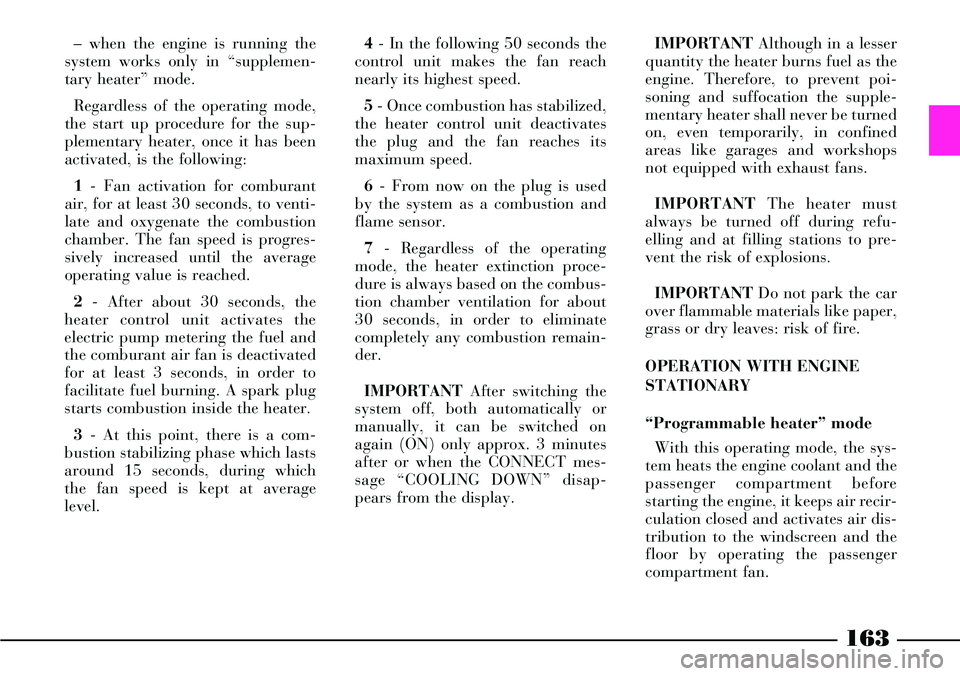
163
– when the engine is running the
system works only in “supplemen-
tary heater” mode.
Regardless of the operating mode,
the start up procedure for the sup-
plementary heater, once it has been
activated, is the following:
1- Fan activation for comburant
air, for at least 30 seconds, to venti-
late and oxygenate the combustion
chamber. The fan speed is progres-
sively increased until the average
operating value is reached.
2- After about 30 seconds, the
heater control unit activates the
electric pump metering the fuel and
the comburant air fan is deactivated
for at least 3 seconds, in order to
facilitate fuel burning. A spark plug
starts combustion inside the heater.
3- At this point, there is a com-
bustion stabilizing phase which lasts
around 15 seconds, during which
the fan speed is kept at average
level.4- In the following 50 seconds the
control unit makes the fan reach
nearly its highest speed.
5- Once combustion has stabilized,
the heater control unit deactivates
the plug and the fan reaches its
maximum speed.
6- From now on the plug is used
by the system as a combustion and
flame sensor.
7- Regardless of the operating
mode, the heater extinction proce-
dure is always based on the combus-
tion chamber ventilation for about
30 seconds, in order to eliminate
completely any combustion remain-
der.
IMPORTANTAfter switching the
system off, both automatically or
manually, it can be switched on
again (ON) only approx. 3 minutes
after or when the CONNECT mes-
sage “COOLING DOWN” disap-
pears from the display. IMPORTANTAlthough in a lesser
quantity the heater burns fuel as the
engine. Therefore, to prevent poi-
soning and suffocation the supple-
mentary heater shall never be turned
on, even temporarily, in confined
areas like garages and workshops
not equipped with exhaust fans.
IMPORTANTThe heater must
always be turned off during refu-
elling and at filling stations to pre-
vent the risk of explosions.
IMPORTANTDo not park the car
over flammable materials like paper,
grass or dry leaves: risk of fire.
OPERATION WITH ENGINE
STATIONARY
“Programmable heater” mode
With this operating mode, the sys-
tem heats the engine coolant and the
passenger compartment before
starting the engine, it keeps air recir-
culation closed and activates air dis-
tribution to the windscreen and the
floor by operating the passenger
compartment fan.
Page 261 of 386
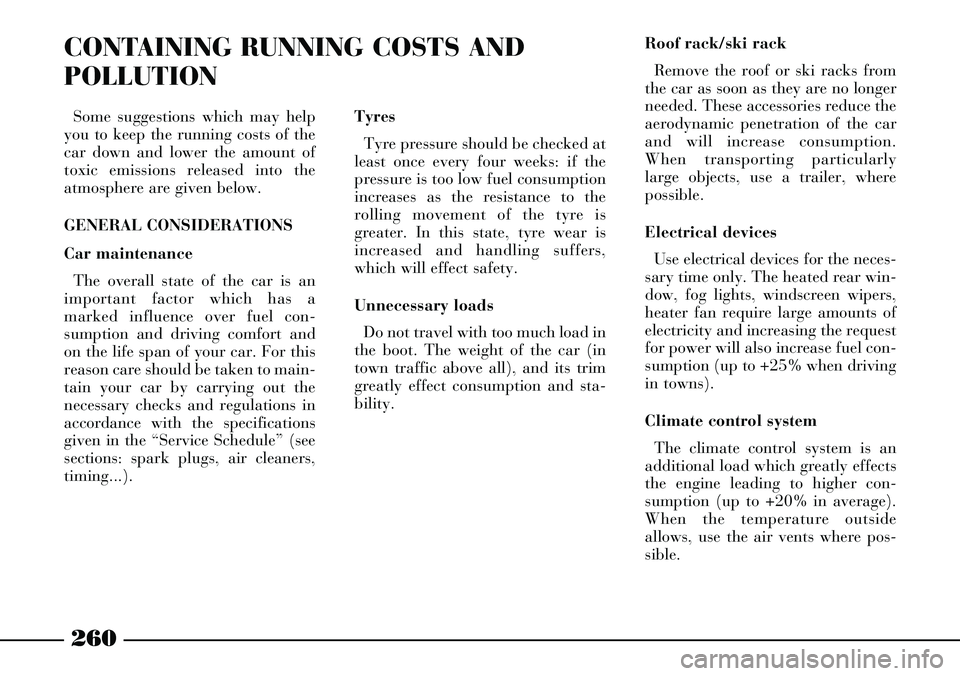
260
CONTAINING RUNNING COSTS AND
POLLUTION
Some suggestions which may help
you to keep the running costs of the
car down and lower the amount of
toxic emissions released into the
atmosphere are given below.
GENERAL CONSIDERATIONS
Car maintenance
The overall state of the car is an
important factor which has a
marked influence over fuel con-
sumption and driving comfort and
on the life span of your car. For this
reason care should be taken to main-
tain your car by carrying out the
necessary checks and regulations in
accordance with the specifications
given in the “Service Schedule” (see
sections: spark plugs, air cleaners,
timing...).Tyres
Tyre pressure should be checked at
least once every four weeks: if the
pressure is too low fuel consumption
increases as the resistance to the
rolling movement of the tyre is
greater. In this state, tyre wear is
increased and handling suffers,
which will effect safety.
Unnecessary loads
Do not travel with too much load in
the boot. The weight of the car (in
town traffic above all), and its trim
greatly effect consumption and sta-
bility.Roof rack/ski rack
Remove the roof or ski racks from
the car as soon as they are no longer
needed. These accessories reduce the
aerodynamic penetration of the car
and will increase consumption.
When transporting particularly
large objects, use a trailer, where
possible.
Electrical devices
Use electrical devices for the neces-
sary time only. The heated rear win-
dow, fog lights, windscreen wipers,
heater fan require large amounts of
electricity and increasing the request
for power will also increase fuel con-
sumption (up to +25% when driving
in towns).
Climate control system
The climate control system is an
additional load which greatly effects
the engine leading to higher con-
sumption (up to +20% in average).
When the temperature outside
allows, use the air vents where pos-
sible.
Page 264 of 386

263
Ignoring the above rules
may lead to fire. When functioning nor-
mally, the catalytic con-
verter reaches high tem-
peratures. For this reason, do not
park the car over inflammable
material (grass, dry leaves, pine
needles, etc.): fire hazard.
Do not allow anything to
be sprayed onto the cat-
alytic converter, lambda
sensor and exhaust pipe. Do not install other heat
shields and do not remove
those already fitted to the
catalytic converter and exhaust
pipe. Never run the engine with the
spark plugs disconnected even for
testing purposes. Do not warm up
the engine by letting it idle for a
while before moving off unless the
outside temperature is very low and,
even in this case, only do so for less
than 30 seconds.
If you have trouble starting, do not
keep turning the ignition key for
long periods. Be especially careful to
avoid bump starting the car by
pushing, towing or rolling downhill:
these are all manoeuvres that can
damage the catalytic exhaust sys-
tem. Use an auxiliary battery for
start-ups only.
If the engine begins to “lose its
smoothness” when travelling, con-
tinue your journey but reduce the
demands you are making on the
engine and have the car seen at a
Lancia Dealershipas soon as you
can.
When the instrument panel fuel
reserve warning light comes on, fill
up as soon as possible. A low level of
fuel can cause an uneven supply of
fuel to the engine with the inevitable
increase in the temperature of the
exhaust gas and serious damages to
the catalytic converter.
Page 298 of 386
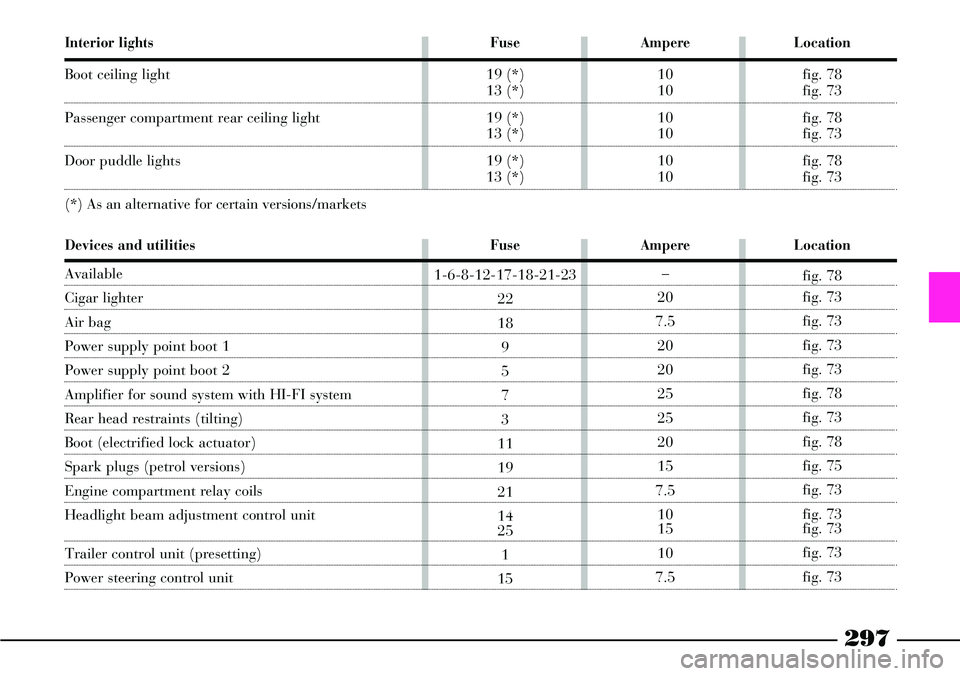
297
Interior lights
Boot ceiling light
Passenger compartment rear ceiling light
Door puddle lights
(*) As an alternative for certain versions/markets
Fuse
19 (*)
13 (*)
19 (*)
13 (*)
19 (*)
13 (*)
Ampere
10
10
10
10
10
10
Location
fig. 78
fig. 73
fig. 78
fig. 73
fig. 78
fig. 73
Fuse
1-6-8-12-17-18-21-23
22
18
9
5
7
3
11
19
21
14
25
1
15
Ampere
–
20
7.5
20
20
25
25
20
15
7.5
10
15
10
7.5
Location
fig. 78
fig. 73
fig. 73
fig. 73
fig. 73
fig. 78
fig. 73
fig. 78
fig. 75
fig. 73
fig. 73
fig. 73
fig. 73
fig. 73
Devices and utilities
Available
Cigar lighter
Air bag
Power supply point boot 1
Power supply point boot 2
Amplifier for sound system with HI-FI system
Rear head restraints (tilting)
Boot (electrified lock actuator)
Spark plugs (petrol versions)
Engine compartment relay coils
Headlight beam adjustment control unit
Trailer control unit (presetting)
Power steering control unit
Page 301 of 386

300
Devices and utilities
Passenger door point (power supply)
Instrument panel point
Steering angle sensor point
(*) As an alternative for certain versions/markets
Parking sensor point
TV tuner point
Boot point
Steering wheel point
Central console control panels
Fuel pump
Doors (electrified lock actuators)
Spark plug pre-heating
EOBD system diagnostic socket
Current socket in boot
Current socket in rear armrest
Parking heater (control unit)
Additional heater
Fuse
10
14
16
19 (*)
13 (*)
19
15
14
15
11
15
15
21
11
2
6
22
13
2
3
4
9
Ampere
20
10
10
10
10
7.5
7.5
10
7.5
20
7.5
7.5
15
20
60
10
20
20
15
20
50
20
Location
fig. 73
fig. 73
fig. 73
fig. 78
fig. 73
fig. 73
fig. 73
fig. 78
fig. 73
fig. 78
fig. 73
fig. 73
fig. 75
fig. 78
fig. 75
fig. 73
fig. 73
fig. 78
fig. 73
fig. 78
fig. 75
fig. 75
Page 314 of 386
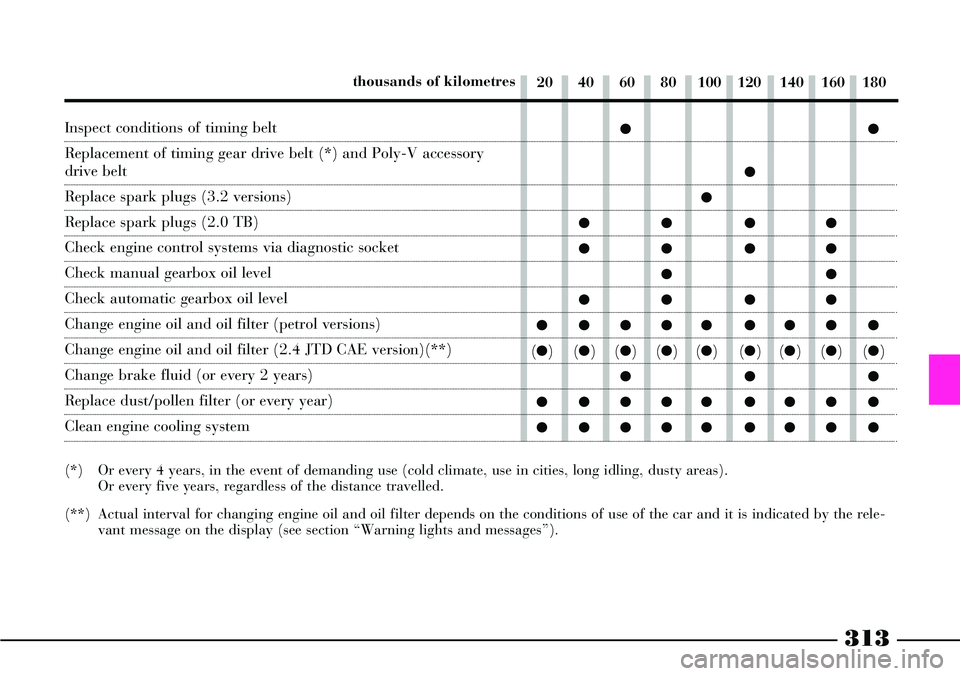
313
Inspect conditions of timing belt
Replacement of timing gear drive belt (*) and Poly-V accessory
drive belt
Replace spark plugs (3.2 versions)
Replace spark plugs (2.0 TB)
Check engine control systems via diagnostic socket
Check manual gearbox oil level
Check automatic gearbox oil level
Change engine oil and oil filter (petrol versions)
Change engine oil and oil filter (2.4 JTD CAE version)(**)
Change brake fluid (or every 2 years)
Replace dust/pollen filter (or every year)
Clean engine cooling system
(*) Or every 4 years, in the event of demanding use (cold climate, use in cities, long idling, dusty areas).
Or every five years, regardless of the distance travelled.
(**) Actual interval for changing engine oil and oil filter depends on the conditions of use of the car and it is indicated by the rele-
vant message on the display (see section “Warning lights and messages”).20 40 60 80 100 120 140 160 180 thousands of kilometres
çç
ç
ç
çç çç
çç çç
çç
çç çç
ççççç çççç
(ç)(ç)(ç)(ç)(ç)(ç)(ç)(ç)(ç)
ççç
ççççç çççç
ççççç çççç
Page 331 of 386

330
SPARK PLUGS
The cleanness and soundness of the
spark plugs are very important for
keeping the engine efficient and pol-
luting emissions down.
The appearance of the spark plug,
if examined by expert eyes, is a good
way of pinpointing a problem even if
it has nothing to do with the ignition
system. Therefore, if the engine has
problems, it is important to have the
spark plugs checked at a Lancia
Dealership.
The spark plugs must be
changed at the times
specified in the Service
Schedule. Only use the type of
plugs indicated. If the heat ratio
is less than required or the life
specified is not guaranteed, prob-
lems can arise.
ELECTRONIC
CONTROL UNITS
When the car is being used normal-
ly, special measures are not neces-
sary.
The following instructions must be
followed very carefully, however, if
you work on the electrical system or
in cases where emergency starting is
necessary:
– never disconnect the battery from
the electrical system while the
engine is running
– disconnect the battery from the
electrical system if you are recharg-
ing it. The modern battery chargers
can discharge voltage up to 20V
– never perform emergency start-
ups with a battery charger. Always
use an auxiliary battery
– be particularly careful when con-
necting the battery to the electrical
system. Make sure that the polarity
is correct and that the connection is
efficient– do not connect or disconnect the
terminals of the electronic control
unit while the ignition key is at MAR
– do not check polarity through
sparking
– disconnect the electronic control
units if you are electrically welding
the car body. Remove the units if
temperatures exceed 80°C (special
operations on the bodywork, etc.).
Modifications or repairs
to the electrical system
carried out incorrectly
and without bearing the features
of the system in mind can cause
malfunctions with the risk of fire.
Page 347 of 386

346
2.0 TB
BOSCH ME7
Multipoint sequential
electronic injection,
electronically controlled
variable geometry
turbosupercharger with
intercooler
Static electronic
integral with
ignition and
single coil
1-2-4-5-3
-
BOSCH FR6KTC
Modifications or repairs to the fuel system that are not carried out properly or do not take the system’s
technical specifications into account can cause malfunctions leading to the risk of fire.
2.4
BOSCH ME3.1
Multipointsequential
electronic injection
Static electronic
integral with
ignition and
single coil
1-2-4-5-3
-
CHAMPION RC8BYC
NGK BKR6EZ2.4 CAE
BOSCH ME3.1
Multipointsequential
electronic injection
Static electronic
integral with
ignition and
single coil
1-2-4-5-3
-
CHAMPION RC8BYC
NGK BKR6EZ
FUEL FEED - IGNITION
Fuel feed
Ignition
Firing order
Injection order
Spark plugs
Page 348 of 386
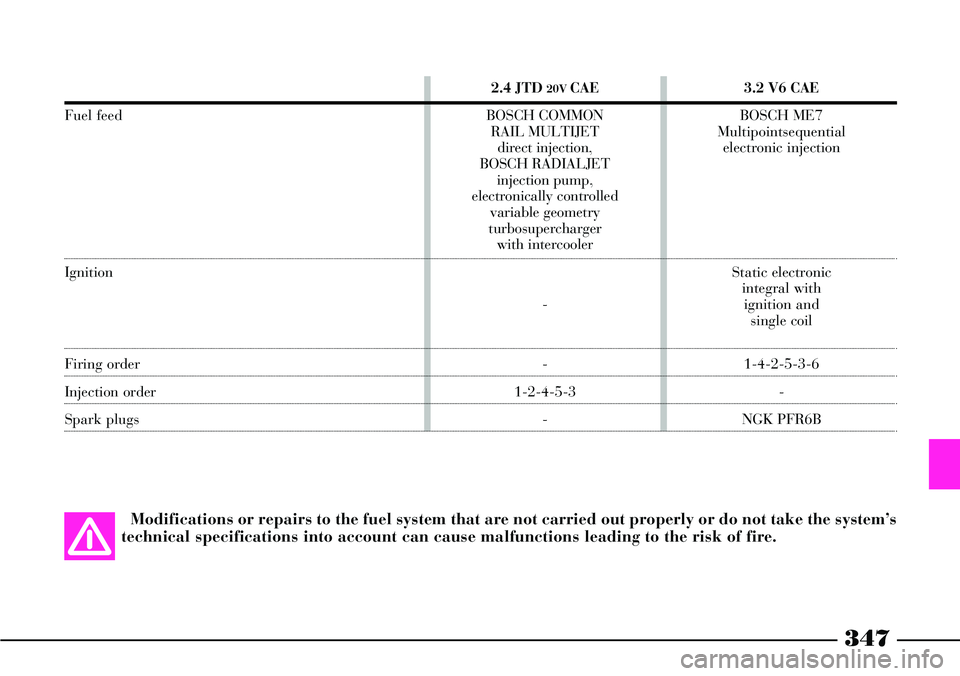
347
Modifications or repairs to the fuel system that are not carried out properly or do not take the system’s
technical specifications into account can cause malfunctions leading to the risk of fire.
3.2 V6 CAE
BOSCH ME7
Multipointsequential
electronic injection
Static electronic
integral with
ignition and
single coil
1-4-2-5-3-6
-
NGK PFR6B 2.4 JTD 20V CAE
BOSCH COMMON
RAIL MULTIJET
direct injection,
BOSCH RADIALJET
injection pump,
electronically controlled
variable geometry
turbosupercharger
with intercooler
-
-
1-2-4-5-3
-
Fuel feed
Ignition
Firing order
Injection order
Spark plugs
Page 379 of 386
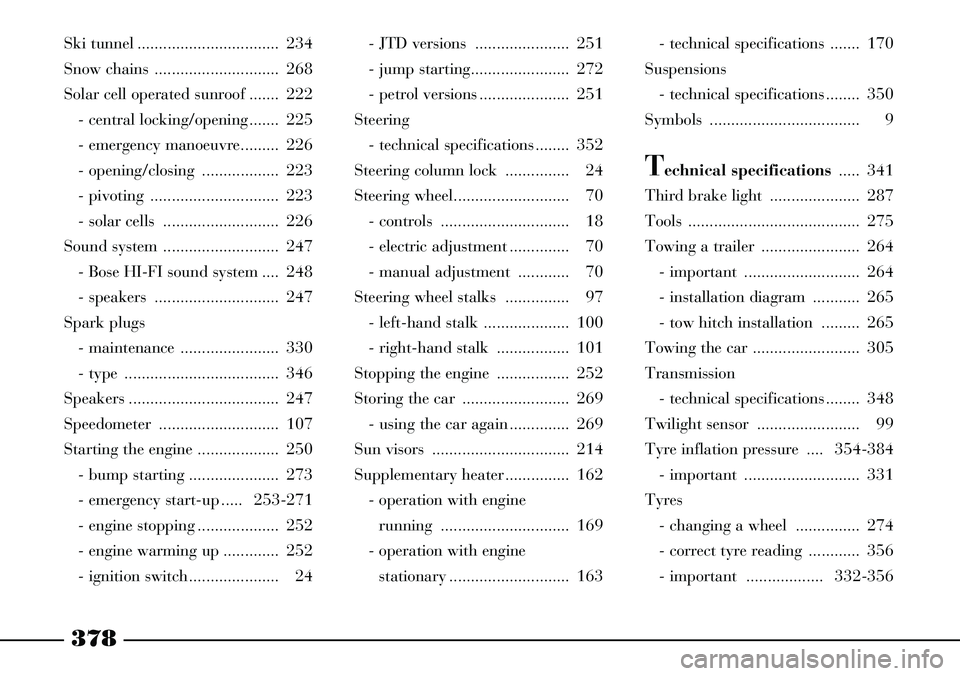
378
Ski tunnel ................................. 234
Snow chains ............................. 268
Solar cell operated sunroof ....... 222
- central locking/opening ....... 225
- emergency manoeuvre......... 226
- opening/closing .................. 223
- pivoting .............................. 223
- solar cells ........................... 226
Sound system ........................... 247
- Bose HI-FI sound system .... 248
- speakers ............................. 247
Spark plugs
- maintenance ....................... 330
- type .................................... 346
Speakers ................................... 247
Speedometer ............................ 107
Starting the engine ................... 250
- bump starting ..................... 273
- emergency start-up ..... 253-271
- engine stopping ................... 252
- engine warming up ............. 252
- ignition switch ..................... 24- JTD versions ...................... 251
- jump starting....................... 272
- petrol versions ..................... 251
Steering
- technical specifications ........ 352
Steering column lock ............... 24
Steering wheel........................... 70
- controls .............................. 18
- electric adjustment .............. 70
- manual adjustment ............ 70
Steering wheel stalks ............... 97
- left-hand stalk .................... 100
- right-hand stalk ................. 101
Stopping the engine ................. 252
Storing the car ......................... 269
- using the car again .............. 269
Sun visors ................................ 214
Supplementary heater ............... 162
- operation with engine
running .............................. 169
- operation with engine
stationary ............................ 163- technical specifications ....... 170
Suspensions
- technical specifications ........ 350
Symbols ................................... 9
Technical specifications..... 341
Third brake light ..................... 287
Tools ........................................ 275
Towing a trailer ....................... 264
- important ........................... 264
- installation diagram ........... 265
- tow hitch installation ......... 265
Towing the car ......................... 305
Transmission
- technical specifications ........ 348
Twilight sensor ........................ 99
Tyre inflation pressure .... 354-384
- important ........................... 331
Tyres
- changing a wheel ............... 274
- correct tyre reading ............ 356
- important .................. 332-356